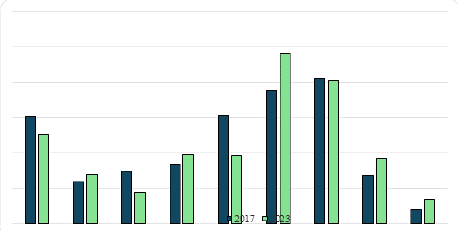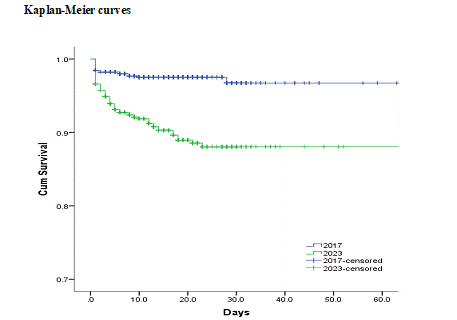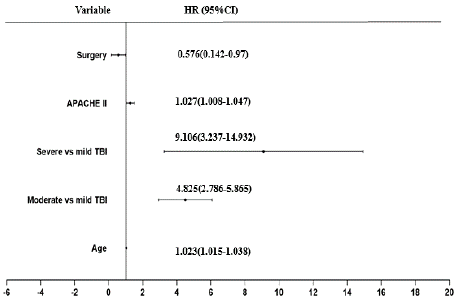
Research Article
Ann Surg Perioper Care. 2025; 10(1): 1070.
Traumatic Brain Injury in Rural China: Changes Before and After 6 Years
Xiao-ting Fan¹, Jian Li¹, Bao-Xiang Gao¹, Yu-Shuang Wang¹, Yi-Qian Tang¹, Hai-Ying Zhao²* Sheng-ji Wang²*
1Department of Neurosurgery ICU, Linyi People’s Hospital, Linyi, Shandong, China
2Emergency Department, Linyi People’s Hospital, Linyi, Shandong, China
*Corresponding author: Hai-Ying Zhao, Emergency Department, Linyi People’s Hospital, Linyi, Shandong, China, No. 27, East Section of Jiefang Road, Lanshan District, Linyi, Shandong, China Email: sdlyzhaohaiying@163.com
Sheng-ji Wang, Emergency Department, Linyi People’s Hospital Affiliated to Shandong University, Linyi, Shandong, China, No. 27, East Section of Jiefang Road, Lanshan District, Linyi, Shandong, China Email: 18954959359@163.com
Received: March 05, 2025; Accepted: March 27, 2025; Published: March 31, 2025;
Abstract
Purpose: More real-world studies are required to better characterise TBI and to identify the most effective treatment approaches. We aimed to describe the changes in treatment and outcome among TBI patients in rural China.
Materials and Methods: We performed a retrospective, descriptive, cross-sectional analysis of patients presenting TBI in LinYi People’s Hospital in 2017 and 2023. We analysed demographic data, including age, sex, mortality, aetiology, treatment, and functional outcome in 2 months.
Results: 1. Compared with patients in 2017, patients in 2023 were older, and more often had moderate and severe TBI. They showed a greater incidence of mortality and poor outcome. More patients in 2023 received multiple surgery therapy, and the hospitalization time had shortened.
2. We found that Surgery, APACHE II score, moderate and severe TBI and Age were independent short term outcome predictors of patients in 2023 group.
Conclusion: The demographic characteristic and clinical treatment of TBI patients has changed significantly in recent years; we should continuously strive to improve treatment strategies based on the current actual situation.
Keywords: traumatic brain injury; epidemiological investigation; risk factors
Introduction
Traumatic brain injury (TBI) is one of the leading causes of death and disability worldwide, the socioeconomic burden of TBI is increasing substantially in China [1]. The preview studies indicate potential for identifying best practices through comparative effectiveness research [2].
Rapid population aging, with higher rates of multi morbidity, which should lead to changes in management approaches [3]. The purpose of this study is to analyze changes in the demographics and treatment of patients with TBI at our hospital before and after 6 years.
Material and Methods
The study followed the principles of the Declaration of Helsinki as revised in 2013. This study was approved by the ethics Committee of Linyi People’s Hospital (YX200116, 2020.12.10). We confirm that all methods were performed in accordance with the relevant guidelines and regulations.As this study was a retrospective study and did not involve the leakage of subject information, the ethics committee approved the exemption of informed consent.
We conducted a descriptive, cross-sectional, retrospective study of all patients admitted to our hospital’s neurosurgery department due to TBI, we analysed 2 different cohorts: patients admitted in 2017, and patients admitted in 2023.
We gathered data on the following epidemiological variables and clinical data: age, sex, mechanism of injury, post-resuscitation GCS score (once the patient was stable and before neurosurgery), baseline injury severity, Rotterdam CT score, Acute Physiology and Chronic Health Evaluation(APACHE) score, comorbidities, duration of stay at hospital(in days), mortality, functional status at 2 months according to the Glasgow Outcome Scale (GOS), emergency neurosurgery and type of intervention (craniotomy/craniectomy), intracranial pressure (ICP) monitoring, and use of an external ventricular drain.
GOS=3 was considered as poor outcome, while GOS=4 was considered as good outcome.
Statistical Analysis
We excluded patients for whom information on discharge status or clinical severity was missing. The distribution pattern of the variables was analyzed using the Kolmogorov–Smirnov test. Continuous variables were reported as median (25th and 75th percentiles), and categorical variables as numbers and percentages. We used the Fisher exact test and the chi-square test to compare categorical variables, and the rank-sum test to analyse continuous variables (non-normal distribution). We also conducted multivariate COX regression analyse with stepwise forward selection to identify independent predictors of poor outcome (GOS=3). Kaplan-Meier survival analysis was done with death time. Statistical analysis was performed using IBM SPSS Statistics for Windows version 21 (IBM Corp., Armonk, New York, United States of America).
Results
Baseline demographic and clinical characteristics for all the patients are shown in Table 1. We enrolled 854 patients in 2017 and 914 patients in 2023. Compared with patients in 2017, patients in 2023 group were older, fewer patients were men (72.4% vs 67.2%; P=0.02), and more often had moderate and severe TBI.
2017(n=854)
2023(n=914)
P
Age
48(26,62)
53(31,71)
0.002
Male,n(%)
618(72.4)
614(67.2)
0.02
GCS score, n(%)
<0.001
Severe (3-8)
136(15.9)
233(25.5)
Moderate (9-12)
211(24.7)
359(39.3)
Mild (13-15)
507(59.4)
322(35.2)
5(3,7)
6(3,9)
0.721
GCS scoring
6(4,8)
5(4,7)
0.583
25(19,30)
28(20,36)
0.021
Systemic hypotension
15(1.7)
28(3.1)
<0.001
hypoxia
101(11.8)
143(15.6)
<0.001
Aetiology n(%)
0.089
Traffic accidents
397(46.5)
451(49.3)
Fall
401(47.0)
421(46.1)
Violence
56(6.5)
42(4.6)
Surgery, n(%)
Decompressive craniectomy
204(23.9)
301(32.9)
ICP sensors
163(19.1)
322(35.2)
231(27.0)
358(39.1)
Mortality, n(%)
21(2.5)
81(8.9)
<0.001
GOS 1-3, n(%)
118(13.8)
257(28.1)
<0.001
Hospital stay, days
14(8,22)
11(5,19)
<0.001
Hospital cost, ¥
17182.33(8850.15,45869.67)
17384.31(7002.93,69479.62)
0.69
Note: GCS: Glasgow Coma Scale; GOS: Glasgow Outcome Scale.
Table 1: Comparison of demographic and clinical data.
There was no statistical difference in Rotterdam CT and admission GCS scoring system between the two groups; The APACHE II score, the proportion of patients with systemic hypotension and hypoxia in the 2023 group were relatively high.
No significant difference in the etiology was discovered; Table 1 showed traffic accidents increased from 46.5% in 2017 to 49.3% in 2023. Falls from the same level or not remain constituted one of the main causes of TBI in the two groups.
More patients from the 2023 cohort received multiple surgery therapy (including decompressive craniectomy, ICP sensors, and exter ventricular drain; P< .001). They showed also a greater incidence of mortality and poor outcome. Overall mortality in 2 months increased from 2.5% in 2017 to 8.9% in 2023, and 28.1% of patients in 2023 presented poor outcome (P < 0.001).
The hospitalization time had shortened in 2023, while no significant difference was observed in the hospital cost.
Figure 1 shows the incidence rates of various age groups in 2017 and 2023. The proportion of injuries among the elderly increased, especially among people aged 50-59 and 70-79.

Figure 1: Comparison of incidence in different age groups over two periods.
The difference in all-cause death between the 2 groups was significant
(log-rank test, P < 0.001) (Figure 2), the survival curve of patients in 2023 significantly decreased within 20 days.

Figure 2: Kaplan-Meier curves for the two groups.
As showed in Figure 3, the multivariate COX regression analysis of poor outcome (GOS=3) at 2 months after TBI in 2023 group found that Surgery was independent favorable outcome predictor; APACHE II score, moderate and severe TBI and Age were independent unfavorable outcome predictors.

Figure 3: Independent risk factors for short-term prognosis of patients in
2023
Discussion
Our study showed significant differences in the population attended at our hospital due to TBI in recent years. We also observed changes in the management of these patients. The results of this study inform policymaking for targeted TBI prevention and management, and provide evidence for decision making on clinical scenarios.
The socioeconomic burden of TBI is increasing substantially, including acute care, rehabilitation, and permanent neurologic disability [4]. We considered short-term poor outcome as the endpoint event and conducted a multivariate COX regression analysis. The outcome predictors for poor prognosis are more socially significant.
In the 2023 group, the frequency of mortality and poor outcome increased, this may be explained by the higher proportion of elderly, multi morbid patients, resulting in poorer surgical prognosis and functional recovery. The proportion of patients with severe TBI was 25.5%, similar to finding (20%) from the latest research on China [5].
As life expectancy has continued to increase, age-related problems have become increasingly common [6,7]. This may have played a role in the change in surgical indication. Population ageing is more frequent in developed countries, such as USA Europe, and is also observed in our population [8]. The incidence of TBI in the elderly population is estimated to have doubled over the past 20 year [5,9].
We found higher APACHE score caused more deaths. This scoring system includes acute physiological and chronic health conditions, which is especially suitable for elderly patients. In the CENTER-TBI study [10], injury severity score, presence of hypoxia, systemic hypotension, were significantly associated with hospital survival in patients with TBI.
Worldwide, moderate and severe TBI accounts for 19% of all cases; and the mortality rates range from 0.9 to 7.6 per 100 persons overall [11,12]. In this study, the mortality rate was 8.9% in 2023 group, the management of polytrauma and elderly patients with multiple complications will be a challenge for future treatment.
The development of driver education programmers leads to a decrease in the incidence of traffic accidents in developed cities [13.14]. But in rural China, the most common cause of TBI is still traffic accident at present [1,6].
The changing age structure of Chinese population combined with further improvements in road-traffic safety will lead to a proportional increase of domestic injuries, particularly in those older than 65 years, this underscores the need to develop new approaches to the management of these patients.
Surgical interventions show therapeutic benefits in patients with signs of brain herniation [15]. Moreover, pre-emptively treating impending brain herniation is preferable [16,17]. The effectiveness of surgical interventions in our study is of particular relevance given the lack of benefit reported in the overall TBI population in previous clinical trials [18]. The overall surgical efficiency cannot be easily demonstrated due to methodological differences among studies. Surgical interventions have not consistently been shown to reduce morbidity and mortality or to improve quality of life in the short term [19]. Decompressive craniectomy is increasingly recommended in China [20]. As shown by the multivariate analyses, surgery was associated with decrease in the likelihood of disability. Our study had several limitations. First, this was a single-center retrospective analysis, we only analysed data on patients admitted to our hospital; Second, no information on long-term complications and outcomes was collected. Finally, the contributions of multiple surgery were not subjected to more detailed subgroup analyses.
The outcome of TBI is greatly influenced by the epidemiological characteristics of the population under study [21]. The risk factors for outcome of TBI patients will change over time, so more large-scale clinical studies are needed to clarify the relevant predictors and collect data on longer-term outcomes.
Conclusion
The epidemiology of TBI has changed over time, which has also changed the management of the condition, with the need to introduce new approaches and strategies focused on achieving better outcomes.
Data Availability Statement
Supplementary information is not publicly available but is available from corresponding author on reasonable request.
References
- Jiang JY, Gao GY, Feng JF, Mao Q, Chen LG, Yang XF, et al. Traumatic brain injury in China. Lancet Neurol. 2019; 18: 286-295.
- Robinson, Christopher P. Moderate and Severe Traumatic Brain Injury. Continuum (Minneapolis, Minn. 2021; 27: 1278-300.
- Zou JF, Fang HL, Zheng J, Ma YQ, Wu CW, Su GJ, et al. The epidemiology of traumatic brain injuries in the fastest-paced city in China: a retrospective study. Front Neurol. 2023; 14: 1255117.
- Capizzi A, Woo J, Verduzco-Gutierrez M. Traumatic Brain Injury: An Overview of Epidemiology, Pathophysiology, and Medical Management. Med Clin North Am. 2020; 104: 213-238.
- Gao G, Wu X, Feng J, Hui J, Mao Q, Lecky F, et al. Clinical characteristics and outcomes in patients with traumatic brain injury in China: a prospective, multicentre, longitudinal, observational study. Lancet Neurol. 2020; 19: 670- 677.
- Xiong W, Qian K. Low-Protein, Hypocaloric Nutrition with Glutamine versus Full-Feeding in the Acute Phase in ICU Patients with Severe Traumatic Brain Injury. Neuropsychiatr Dis Treat. 2021; 17: 703-710.
- Maas AIR, Menon DK, Manley GT, Abrams M, Åkerlund C, Andelic N, et al. Traumatic brain injury: progress and challenges in prevention, clinical care, and research. Lancet Neurol. 2022; 21: 1004-1060.
- Brett BL, Gardner RC, Godbout J, Dams-O’Connor K, Keene CD. Traumatic Brain Injury and Risk of Neurodegenerative Disorder. Biol Psychiatry. 2022; 91: 498-507.
- GBD 2019 Diseases and Injuries Collaborators. Global burden of 369 diseases and injuries in 204 countries and territories, 1990-2019: a systematic analysis for the global burden of disease study 2019. Lancet. 2020; 396: 1204–1222.
- Steyerberg EW, Wiegers E, Sewalt C, Buki A, Citerio G, De Keyser V, et al. Case-mix, care pathways, and outcomes in patients with traumatic brain injury in CENTER-TBI: a European prospective, multicentre, longitudinal, cohort study. Lancet Neurol. 2019; 18: 923-934.
- Haarbauer-Krupa J, Pugh MJ, Prager EM, Harmon N, Wolfe J, Yaffe K. Epidemiology of Chronic Effects of Traumatic Brain Injury. J Neurotrauma. 2021; 38: 3235-3247.
- Laing J, Gabbe B, Chen Z, Perucca P, Kwan P, O’Brien TJ. Risk Factors and Prognosis of Early Posttraumatic Seizures in Moderate to Severe Traumatic Brain Injury. JAMA Neurol. 2022; 79: 334-341.
- Kim K, Priefer R. Evaluation of current post-concussion protocols. Biomed Pharmacother. 2020; 129: 110406.
- Ashraf M, Kamboh UA, Hussain SS, Raza MA, Mehboob M, Zubair M, et al. Traumatic Brain Injury in Underage Motorcycle Drivers: Clinical Outcomes and Sociocultural Attitudes from a Lower-Middle-Income Country. World Neurosurg. 2022; 167: e413-422.
- Retel Helmrich IRA, Lingsma HF, Turgeon AF, Yamal JM, Steyerberg EW. Prognostic Research in Traumatic Brain Injury: Markers, Modeling, and Methodological Principles. J Neurotrauma. 2021; 38: 2502-2513.
- Salmi LR, Cassidy JD, Holm L, Cancelliere C, Côté P, Borg J. Introduction to the findings of the International Collaboration on Mild Traumatic Brain Injury Prognosis: what is a prognostic study? Arch Phys Med Rehabil. 2014; 95: S95-100.
- Carney N, Totten AM, O’Reilly C, Ullman JS, Hawryluk GW, Bell MJ, et al. Guidelines for the Management of Severe Traumatic Brain Injury, Fourth Edition. Neurosurgery. 2017; 80: 6-15.
- Yang B, Sun X, Shi Q, Dan W, Zhan Y, Zheng D, et al. Prediction of early prognosis after traumatic brain injury by multifactor model. CNS Neurosci Ther. 2022; 28: 2044-2052.
- Yu T, Liu X, Sun L, Lv R, Wu J, Wang Q. Predicting Global Functional Outcomes Among Post-traumatic Epilepsy Patients After Moderate-to- Severe Traumatic Brain Injury: Development of a Prognostic Model. Front Neurol. 2022; 13: 874491.
- Wang R, Hua Y, He M, Xu J. Prognostic Value of Serum Procalcitonin Based Model in Moderate to Severe Traumatic Brain Injury Patients. J Inflamm Res. 2022; 15: 4981-4993.
- Avsenik J, Bajrovic FF, Gradišek P, Kejžar N, Šurlan Popovic K. Prognostic value of CT perfusion and permeability imaging in traumatic brain injury. J Trauma Acute Care Surg. 2021; 90: 484-491.